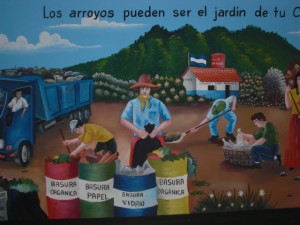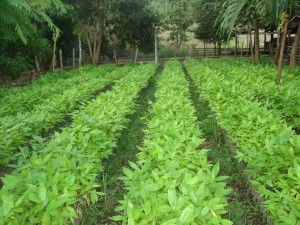We have written before about the wealth of projects and micro-initiatives undertaken by individual residents of Granada. This week, three green initiatives came to the fore, plus one interesting milestone for CO2 Bambu.
Waterways clean up: Leslie, a Northern California native, economist by training and Urban Renewal specialist has taken partial residence in Granada. She shares her time between Sonoma Valley, Nicaragua and the African country of Zambia. Driven by a personal green agenda, she has chosen to tackle Granada’s polluted waterways. The problem for Granada is that there is little consciousness about Green “right” or “wrong” and people freely throw in the streets all manners of trash. But the problem doesn’t stop at residential trash. A large nearby soap factory is a notable polluter, releasing detergents freely and overtly into the river system that flows around and through the city. Individuals think nothing of pouring their toxic materials, such as paint thinners into the streams. Considering Granadas’ position on the edge of Nicaragua’s splendid Lake Cocibolca – the largest body of fresh water in Latin America, even the most obtuse observers can readily see that there is much to be done in Granada on the green front.
So Leslie has connected with the Mayor’s office and, specifically, the city’s Environmental Officer. We have not met the man (yet), but we understand that he has a broad understanding of the task he faces and has already demonstrated some creativity in dealing with the challenge, starting with a weekly radio show dedicated to green issues, to educate the local population.
With the city’s coordination, Leslie was able to map out the waterways’ pressure points and zeroed in on a community that combines the twin traits of being the poorest barrio in the city and being perched on a principal tributary of the river system. Most residents are unemployed. This is a community whose population lives on less than $2 a day. Leslie’s project is to create a paid “green brigade” out of this community and start with a massive cleaning of the area. Recycling will only be one aspect.

 Granada’s main drag – Calle Calzada: When we first discovered Granada three years ago, Calle Calzada was entering a rebuilding phase. One block had been repaved with cobblestones. In its pursuit of a UN Heritage Site title, Granada finally opted to beautify its streets and become a tourism destination, in the tradition of Antigua, Guatemala and Cartagena, Colombia, both Colonial cities dating roughly from the same period as Granada. Today, the same Calle Calzada has been repaved down over six blocs, from Parque Central all the way down to the large unrestored Guadalupe church, two thirds of the way down to the lake. With each new tranche of reconstruction, there springs new restaurants. Not quite Paris’ Champs Elyzees or Barcelona’s Ramblas, but Calzada is definitely the single most successful street at attracting tourists for evening activities. Weekends are very much a time for Managuan families to come and get an injection of Colonial beauty, and Calzada is the destination of choice. So the number of SUVs and Managua-plated cars explodes on the week end. There is traffic (something of a joke if you know the paucity of cars in Granada). The cars “cruise” the street and emit CO2 accordingly.
Granada’s main drag – Calle Calzada: When we first discovered Granada three years ago, Calle Calzada was entering a rebuilding phase. One block had been repaved with cobblestones. In its pursuit of a UN Heritage Site title, Granada finally opted to beautify its streets and become a tourism destination, in the tradition of Antigua, Guatemala and Cartagena, Colombia, both Colonial cities dating roughly from the same period as Granada. Today, the same Calle Calzada has been repaved down over six blocs, from Parque Central all the way down to the large unrestored Guadalupe church, two thirds of the way down to the lake. With each new tranche of reconstruction, there springs new restaurants. Not quite Paris’ Champs Elyzees or Barcelona’s Ramblas, but Calzada is definitely the single most successful street at attracting tourists for evening activities. Weekends are very much a time for Managuan families to come and get an injection of Colonial beauty, and Calzada is the destination of choice. So the number of SUVs and Managua-plated cars explodes on the week end. There is traffic (something of a joke if you know the paucity of cars in Granada). The cars “cruise” the street and emit CO2 accordingly.
This week, a much awaited city policy has taken effect – Calzada has turned pedestrian! Gone are the tailgating cars. One more point in the green column for Granada!
Christmas fundraising turns green: We recently blogged about the Christmas Committee for our street and our being invited to participate as “good neighbors”. We started to reach out to the other “gringos” on the street and approached Warren, the owner of PURE gym, and yoga guru, to ask him to contribute a spa massage to be raffled off in order to generate funds for the music band to play on December 25. Warren responded most generously and offered two gifts. Then, he went turbo, and decided to seize the opportunity to kickstart a neighborhood recycling project he had thought about but had not yet launched. So this week’s neighborhood meeting was an opportunity to test the waters and run by the “committee” whether they thought people would separate plastics from paper, from glass, from … and bring said recyclables to a new set of canisters to be purchased by Warren. He will organize a recycling firm picking up the material once a week or however often it gets filled up. The sorted material will be sold and the money will go toward paying for the effigy of the Virgin Mary. For Calle Corralles, our street, Christmas will be green this year.
 CO2 Bambu in the Cruzada Nacional de Reforestacion: Notwithstanding the last minute disappointment of losing an expected investor in CO2 Bambu, the business continues to achieve important milestones. This week, we learned that the Ministry of Agriculture and Forestry had opted to include us in the 2010 national plan for reforestation. CO2 Bambu’s share under the Cruzada Nacional de Reforestacion is to reforest three hundred hectares of bamboo in the regions of Matagalpa and RAAN. At four hundred plants per hectare, this means we will need to grow 120,000 guadua plants. We will need (assuming we succeed in current efforts to secure alternative financing) to set up a number of “viveros” (nurseries) to grow plants from bamboo seeds. This year, we created thirteen nurseries and grew 82,000 plants. So 120,000 is an achievable target. CO2 Bambu is part of the reforestation establishment and we will do all we can to do our part and meet the reforestation target.
CO2 Bambu in the Cruzada Nacional de Reforestacion: Notwithstanding the last minute disappointment of losing an expected investor in CO2 Bambu, the business continues to achieve important milestones. This week, we learned that the Ministry of Agriculture and Forestry had opted to include us in the 2010 national plan for reforestation. CO2 Bambu’s share under the Cruzada Nacional de Reforestacion is to reforest three hundred hectares of bamboo in the regions of Matagalpa and RAAN. At four hundred plants per hectare, this means we will need to grow 120,000 guadua plants. We will need (assuming we succeed in current efforts to secure alternative financing) to set up a number of “viveros” (nurseries) to grow plants from bamboo seeds. This year, we created thirteen nurseries and grew 82,000 plants. So 120,000 is an achievable target. CO2 Bambu is part of the reforestation establishment and we will do all we can to do our part and meet the reforestation target.
You’re on one heck of a roller coaster! Bend but don’t break just like bamboo.
Funny you should say this, Boyd… My favorite (Ben) fable as a kid in France was “le chaine et le roseau” (i.e. the oak tree and the bamboo)… a fable by Jean de la Fontainre, itself an update of a Greek fable. The moral of the story: he who bends with the wind, survives the storm (whereas the oak tree does not bend and thus breaks). So bending I am, and in fact off to my regular yoga class, so that my body can bend along with my “brain”…